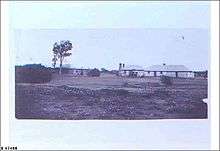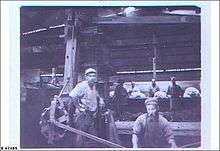Nilpena
Nilpena Station is a pastoral lease that operates as a sheep station in South Australia.



It is situated approximately 44 kilometres (27 mi) west of Blinman and 99 kilometres (62 mi) north of Hawker in the Flinders Ranges and bounded by Lake Torrens.[1] It occupies an area of 800 square kilometres (309 sq mi).[2]
History
Thomas Elder and Robert Barr Smith acquired Nilpena in 1859.[3]
William James Browne owned the property in 1879 when he had the drover Giles take 12,000 sheep from Nilpena and overland them all the way to his new properties Newcastle Waters and Delamere Stations. Only 8000 sheep survived the journey, but it was still regarded as one of the most remarkable droving feats in Australian history.[4] Browne appointed Roderick John Matheson to manage the property, along with Arkaba Station.[5] Matheson and John Lewis later bought Nilpena, with Matheson later buying out Lewis.
In 1925, the Old Nilpena Station was placed on the market for auction. At this time it occupied 31,404 acres (127.09 km2)[6] and was stocked with over 3000 merino sheep. It failed to reach the reserve price of £11,750.[7]
Matheson still owned the property in 1926, along with neighbouring Warrioota Station, which together occupied an area of 350 square miles (906 km2). He was running about 15,000 sheep across the two properties.[8]
By 1944 the property was carrying 7000 sheep.[9]
In 1950, the station was run by the Nilpena Pastoral Company, whose managing director was a Mr Toll. In that year, the station received 18 months' worth of rain over three days, some 11.6 inches (295 mm). The 216,000 acres (874 km2) property had over 10,000 acres (40 km2) completely under water. Mr Toll estimated at the time that the property would have sufficient feed guaranteed for the next two years.[1]
Some time prior to the 1980s, the Fargher family acquired the property. Ross Fargher discovered a pristine Ediacaran fossil site in the 1980s that later became the focus of groundbreaking research, and an application being made for World Heritage listing to help protect the site.[10]
In 2009, the fossils and the property featured on the David Attenborough program First Life.[2]
See also
References
- "Wonderful Rain in North". The Advertiser. Adelaide: National Library of Australia. 6 February 1950. p. 1. Retrieved 3 August 2014.
- Tim Lloyd (20 August 2011). "$24m gamble to save fossils". The Advertiser.
- "The Early South Australian Pastoral Industry". Flinders Range Research. 2014. Retrieved 2 August 2014.
- Michael Pearson; Jane Lennon. Pastoral Australia: Fortunes, Failures and Hard Yakka : a Historical Overview 1788-1967. CSIRO publishing. p. 104. ISBN 9780643096998.
- "Matheson, Roderick John (1862–1913)". Australian Dictionary of Biography. Australian National University. 15 May 1913. Retrieved 2 August 2014.
- "Pastoral". The Register. Adelaide: National Library of Australia. 22 October 1925. p. 5. Retrieved 3 August 2014.
- "Sale of Station property". The Register. Adelaide: National Library of Australia. 30 October 1925. p. 9. Retrieved 3 August 2014.
- "Pastoral Commission". The Register. Adelaide: National Library of Australia. 8 July 1926. p. 12. Retrieved 3 August 2014.
- "Adelaide Branch A.W.U." The Australian Worker. Sydney, New South Wales: National Library of Australia. 12 July 1944. p. 12. Retrieved 15 October 2014.
- Gage, Nicola. Flinders Ranges fossils documented as part of World Heritage listing bid ABC News, 13 February 2017. Retrieved 24 March 2020.